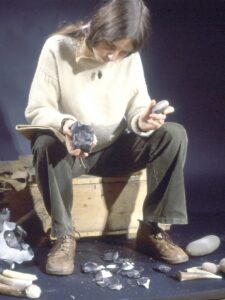
A recent paper in The Conversation, a news platform based on academic writing and research, asks ‘Where were all the women in the Stone Age?’.
It is a good question and the author is to be credited for posing it. Unfortunately, the ensuing text is full of contradiction and occasional bias. Nevertheless, it is a topic that should, perhaps, be required thinking for all of us who work in prehistory at least once a year. To approach it, we need to go back to the basics.
We do, of course, have plenty of evidence from Stone Age prehistory. But, how can we be sure – who are the women? The one immutable fact is that those who died while giving birth were female. After that, it gets more difficult. Where we have skeletal material, it is often possible to provide details, but this relies on the right bones being present and sometimes they are not.
Even where we think we can see the women of the past, all too often it relies on the ways in which we relate finds to people, and interpret gender, in order to get an overview of society. This is not always an easy matter.
Some activities, and by inference the material culture associated with them, are interpreted today as related to women. But this is not infallible. As the paper, itself, notes, grinding stones and bread making in early societies are often assumed to be related to women’s activities. And yet, in our society, when practiced at a more industrial level, these tasks are often associated with men.
Elsewhere, the recovery of needles and other tools associated with sewing is often regarded as indicative of the presence of women. And yet, for those who hunt in extreme environments away from home, such as Inuit men, the ability to sew, and the possession of a sewing kit, can make the difference between life and death. A sewing kit is not, necessarily, a gendered piece of equipment.
There are, as Jarvenpa and Brumbach point out, no hard and fast rules relating to specific activites, hunter-gatherers, and gender.
Moving forward in time, many of the tasks related to farming are often written of as the province of men. Setting aside (for this piece), the role of children in the agricultural labour force, it is worth reminding ourselves that women have been known to provide traction and to care for animals; even, in the case of marauding Vikings, to keep the farms going in the absence of men. I was heartened to read of farmwomen, in a recent piece on the Norse settlement of Greenland (those men, I hasten to add, were all off hunting walrus).
We need to accept that the study of gendered behaviour (indeed, all behaviour), in the past needs to transcend modern ideals and biases. With this in mind, two things strike me.
- Perhaps we need to accept that at times, and in different places, the past was chauvinistic, biased, and not a nice place to be. It often seems to me that we are chasing an egalitarian, hedonistic, utopian past that is unlikely to have existed, and is more a reflection of our desire to put right the inadequacies of our own times. We are not always going to find what we look for. Or even material that we can be comfortable with.
- Perhaps, in assuming that all the traces that we excavate reflect men, we are guilty of just such biases ourselves. The idea of male knappers has been under fire for a while; why do we not see women as hunters, housebuilders, firemakers? Does this say more about our own ideas of suitable activities than it does about the past? I’m reminded of the story I once heard Mike Pitts telling about the recovery of a skeleton from the Neolithic flint mines at Grimes Graves in Norfolk. The papers were full of stories of a poor unfortunate miner killed by rock fall, until the skeleton was sexed, whereupon the stories changed to recount how the miner’s wife had apparently been taking down his midday piece…
Where are the women of prehistory?
My guess is that they are there, yet we are blind. The problem lies not so much in the evidence we recover, as in our lack of understanding.
You must be logged in to post a comment.